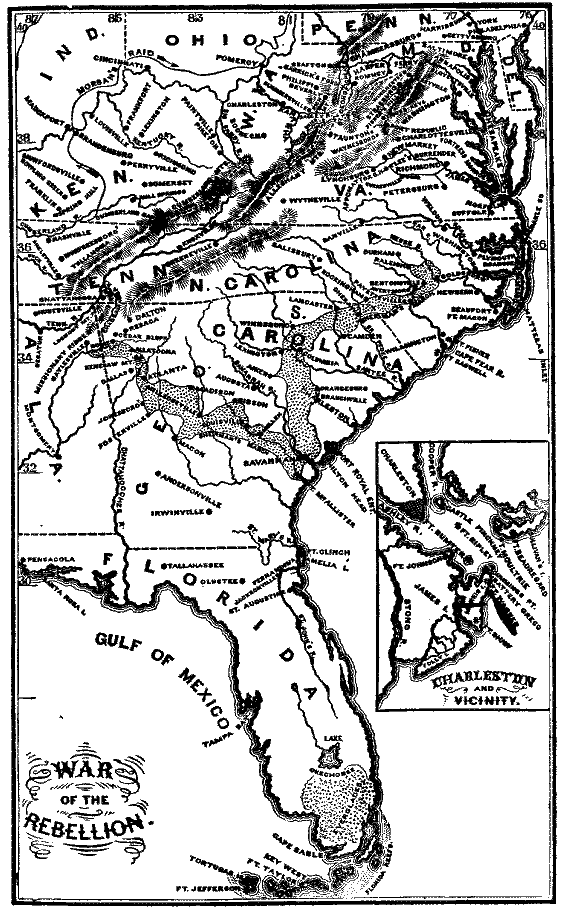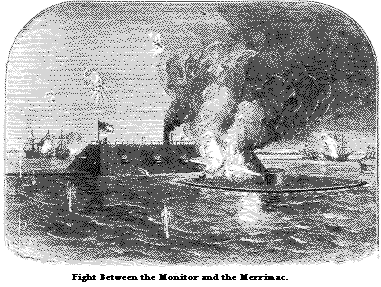NEGenWeb Project
Resource Center OLLibrary
|
|
263 |

|
264 |
|
23. The Confederates
evacuated Pensacola,1 May 9, after setting fire
to the navy-yard, and all property, public and private, within
their reach. On the Texan shore of the Gulf, ![]() Commander
Renshaw approached Galveston, with four steamers, in
October, and took the city. It was recaptured by the Texans on the
first day of the next year.2
Commander
Renshaw approached Galveston, with four steamers, in
October, and took the city. It was recaptured by the Texans on the
first day of the next year.2
24. On the Atlantic
coast,3 the national forces gained a foothold in
Eastern Florida; and, April 11, Fort Pulaski,
commanding the mouth of the Savannah, yielded to Union troops.
Expeditions for these purposes were
fitted out at Port Royal. In March Fernandina, Jacksonville, and
several other places along the eastern coast of Florida
were taken. To reduce Fort Pulaski, batteries were erected
on Tybee Island by Captain Quincy A. Gillmore.4 After a
bombardment of a day and a half, the fort, with its immense
stores, surrendered to General Hunter,5 who then had
command in that department. The next month Hunter issued a
proclamation declaring South Carolina, Georgia, and Florida under
martial law, and the slaves in these states, consequently,
free. This declaration the president overruled, as he had done in
the case of Frémont's proclamation6 in
Missouri.
25. A land and naval
expedition, under General Ambrose E. Burnside7 and
Commodore Louis M. Goldsborough, sailing from Fortress Monroe,
entered Hatteras Inlet, North Carolina, dispersed the rebel
fleet in the Sound, and captured the forts on Roanoke
Island, February 7 and 8, after a severe fight.8
The fleet pursued the Confederate flotilla, captured or destroyed
it, and with the army took many settlements on the Sound, and kept
the rest in continual alarm. Newbern, after a hot
engagement, was taken, March 14. Beaufort yielded, without
resistance, on the 25th; and a month later Fort Macon
surrendered,9 after a bombardment of several hours.
Nearly the whole coast of North Carolina thus lay at the mercy of
the victors.
26. On the 8th of March10 the
rebel iron-clad ram Merrimac, steaming out from Norfolk,
made a descent on the national fleet
1 See p. 251, ¶ 30. 2 See p. 281, ¶ 67. 3 See p. 251, ¶ 331. 4 See p. 305, ¶ 43.
5 See p 249, ¶ 23. 6 See p. 249, ¶ 22. 7 See p. 291, ¶ 10.
8 The fight began the day after the capture of Fort Henry. See p. 254, ¶ 4.
9 The day on which Farragut appeared before New Orleans. See p. 260 ¶ 20.
10 The day on which was decided the battle of Pea Ridge. See p. 258, ¶ 15.
QUESTIONS. -- 23. Give an account of the evacuation of Pensacola. Of the operations at Galveston. 24. What did the national forces gain this year in Eastern Florida, and what at the mouth of the Savannah? What more can you tell of the expedition to Florida? Of the reduction of Fort Palaski? What proclamation did Hunter issue? 25. Give an account of the capture of Roanoke Island, and of other operations on the coast of North Carolina. 26. What can you tell of the operations of the Merrimac and Monitor in Hampton Roads?
|
|
265 |
in Hampton Roads, destroyed two large vessels of war, and at evening seemed only to wait for the dawn of another day to complete the destruction of the whole fleet. But during the night the Union floating battery Monitor opportunely arrived, and the next morning attacked the Merrimac, and drove her, considerably injured, back to Norfolk.

When the Federals abandoned the navy-yard at Norfolk,1 they scuttled and sunk the Merrimac, one of the finest frigates of the American navy. This ship was afterwards raised by the rebels, cut down nearly to the water's edge, plated with iron, armed with ten heavy guns, and named the Virginia. As she approached, the national vessels fired upon her, but their shot glanced harmless from her iron roof. At the close of her day's havoc, the greatest consternation prevailed at Fortress Monroe and in the Union fleet. The rebel monster had already sunk the sloop of war Cumberland, captured and destroyed the frigate Congress, and disabled other Union vessels. The Cumberland, fighting to the last, went down with her flag still flying; and the Congress surrendered only after resistance was hopeless. But a new actor now came upon the scene. At night there entered the harbor a vessel which seemed to be a small raft, with a round tower in the centre. This was an iron-clad battery called the Monitor, constructed on a new principle, by Captain John Ericsson. The tower contained
1 See p. 241, ¶ 5.
QUESTION. -- What more can you tell of the Merrimac and the first day's fight?
23
|
266 |
|
her armament of two powerful guns. When the Merrimac advanced
in the morning, assured ![]() of
an easy victory, the little Monitor steamed boldly out to meet
her. For four hours the battle raged, when the Merrimac withdrew
from the contest. The Union fleet was saved by the Monitor. Her
brave commander, Lieutenant John L. Worden,1 was,
severely injured in the eyes by the concussion of a shot which
struck the pilot-house.2
of
an easy victory, the little Monitor steamed boldly out to meet
her. For four hours the battle raged, when the Merrimac withdrew
from the contest. The Union fleet was saved by the Monitor. Her
brave commander, Lieutenant John L. Worden,1 was,
severely injured in the eyes by the concussion of a shot which
struck the pilot-house.2
27. In
Virginia3 events of the deepest moment occurred
during this year. Early in February General Lander4
expelled the Confederate troops from the Upper Potomac; and
later in the same month General Nathaniel P. Banks,5
crossing from Maryland, pressed the rebels, under General Thomas
J. Jackson, popularly known as Stonewall Jackson,6 up
the Valley of the Shenandoah. General Shields,4
in command of Banks's advance, having enticed the rebel chief back
to Winchester, fell upon him, March 23, and drove him back
with severe loss.7 Jackson was pursued up the valley by
Banks.
28. The greater part of the Army of
the Potomac, under General McClellan,8 had for
several months remained inactive opposite Washington, to be
disciplined, armed, and instructed. Early in March McClellan
advanced, and on the 10th took possession of Manassas,
which had been evacuated by the rebels. On the next day he was
relieved of his duties as general-in-chief, and permitted to give
his undivided attention to the Army of the Potomac. General
Frémont9 took command of the troops in West
Virginia and East Tennessee, General Banks of those in
the Valley of the Shenandoah, and General
McDowell10 of those on the Rappahannock.
29. General McClellan embarked his troops
at Alexandria for Fortress Monroe, intending to advance upon
Richmond from that point. On the 4th of April he began his march
up the peninsula formed by the James and York Rivers. Finding
1 See p. 285, ¶ 77. 2 See p. 282, ¶ 69. 3 See p. 242, ¶ 8--248, ¶ 17.
4 Lander (see p. 247, ¶ 16) died March 2,1862, of congestion of the brain, induced by overexertion while still suffering from a wound received in battle. His division was joined to Banks's corps, and put under the command of General Shields (see p. 217, note 2, and p. 269, ¶ 34).
5 See p. 288, ¶ 4.
6 Jackson was in command of a brigade at the battle of Bull Run, which was reported, at a critical moment, to have "stood like a stone wall." (Seep. 217, note 2, and p. 283, ¶ 72.)
7 The action fought here is also called the battle of Kernstown.
8 See p. 246, ¶ 13. 9 See p. 248, ¶ 20. 10 See p. 243, ¶ 11.
QUESTIONS. -- What can you tell of the Monitor and the second day's fight? 27. What is said of events in Virginia during the year 1862? Of operations on the Upper Potomac? In the Shenandoah Valley? Of the battle at Winchester and its result? 28 What is said of the Army of the Potomac? When did McClellan advance, and of what did he take possession? What change was made in McClellan's command? Who took command in West Virginia and East Tennessee? Who in the Shenandoah Valley? Who on the Rappahannock? 29. What did McClellan next do, and with what intention?
|
|
267 |
the rebels in force behind very strong works at
Yorktown, he laid siege to that place. His army, before the
close of the siege, numbered considerably more than a hundred
thousand effective men. The rebels held out for a month, when they
evacuated Yorktown, and retreated towards Richmond. They were
overtaken, May 5, at Williamsburg, and after a severe
fight, again retreated. A few days later General Wool1
took possession of Norfolk, and the Confederates destroyed
the Merrimac,2 to prevent her from falling into loyal
hands. Soon after, the national gunboats attempted to reach
Richmond, by the James, but were repulsed at Fort
Darling.
30. McClellan
moved forward towards Richmond, and establishing his base of
supplies at White House, on the Pamunkey threw the left wing of
his army across the Chickahominy. This wing was attacked by the
Confederates, May 31, near Seven Pines and Fair
Oaks. The battle raged part of two days, when the rebels,
foiled of their object, hurried in disorder back to Richmond. The
Confederate Commander, General Joseph E. Johnston,3 was
so severely wounded that he was relieved from active duty, and
General Robert E. Lee4 took command of the Confederate
army in front of Richmond.
About thirty thousand national troops,
belonging to the corps of Generals Keyes and Heintzelman, had
crossed the Chickahominy. General Johnston, with near fifty
thousand men, fell upon this part of the Union army, hoping to
annihilate it before aid could reach it from the other side of the
river. The attack was made in front of Seven Pines. The
Federals fought bravely, but were forced back before the
overpowering numbers of the enemy. McClellan's left wing seemed
doomed, when the day was saved by the promptitude of General
Sumner,5 who threw General Sedgwick's6
division of his command across from the north side of the
river just in time to meet near Fair
Oaks Station, and hurl back a fresh column of the enemy coming
down upon the hard-pressed forces of Heintzelman and Keyes. Night
closed the battle. The next day (June 1) a rebel division engaged
a portion of Sumner's line, but was repulsed, when the whole
Confederate army withdrew. The Union loss was less than six
thousand; that of the rebels greater.
1 See p. 253, note 3; p. 213, ¶ 6, and note 1; and p. 174, ¶ 5. 2 See p. 264, ¶ 26.
3 See p. 245, ¶ 12. 4 See p. 247 ¶ 17.
5 See p. 217, note 2, and p. 270. ¶ 38. 6 See p. 217: note 2.
QUESTIONS. -- Give an account of the capture of Yorktown. Of the battle of Williamsburg. What did General Wool do a few days afterwards? What is said of the destruction of the Merrimac? Of the Federal repulse at Fort Darling? 30. Advancing towards Richmond, where did McClellan establish his base of supplies? What did he do with the left wing of his army? Give an account of the battles of Fair Oaks and Seven Pines. Who now took command of the Confederate army? -- Give further particulars of the battles of Seven Pines and Fair Oaks.
|
|
|
|
|
|
© 1999, 2000, 2001 for NEGenWeb Project by Ted & Carole Miller